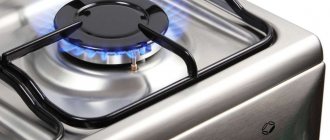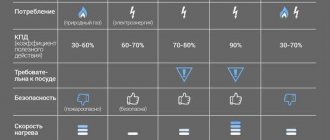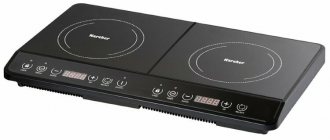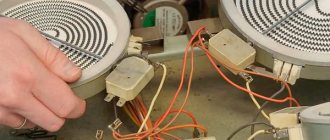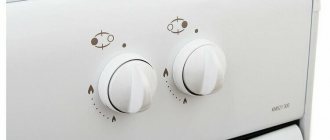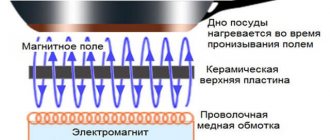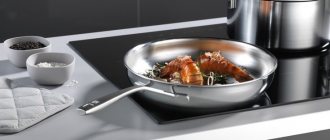Halogen stove: operating principle
It got its name because of the hob with halogen burners . It may consist of only one hob or also have an electric oven, which is equipped with a halogen heating element.
Works on the principle of a halogen emitter . The heating element is a spiral-shaped quartz tube filled with bromine or iodine vapor and having a refractory spiral inside. It heats up under the influence of an electric current passing through it, begins to glow, and releases heat to heat the hob. Iodine and bromine vapors help restore the surface of the spiral, extending its service life.
The halogen burner heats up in 3-5 seconds to maximum temperature. Therefore, cooking time and energy costs are significantly reduced compared to conventional electric ovens.
The hob may have 1-4 halogen burners . It is covered with heat-resistant glass or glass ceramics and is absolutely flat. You can distinguish a halogen stove by the “H” icon (from the Latin - Halogen) on its surface.
Advantages of a halogen stove
- High heating speed . Heating to the set temperature occurs as quickly as possible - 3-5 seconds. This saves time on cooking. For comparison, a regular electric oven heats up in 10 minutes, and a fast heating burner takes 6-7 minutes. In 2-3 minutes, 2 liters of water boils. By saving time, energy consumption for heating is reduced.
- Use of utensils made of any material and any size . Steel, enamel, cast iron, aluminum, glass, ceramics - cookware made from these materials can be used for cooking on a halogen stove. For good heat transfer, the bottom of the pan must be level. Its diameter doesn't matter. For efficient operation, the size of the heating surface can be increased or decreased to match the diameter of the bottom of the pan. For the oval bottom there is a burner of the same shape.
- The heat does not spread over the entire hob . The thermal energy emitted by the burner acts in a directional manner and is spent exclusively on heating the cookware and its contents. The adjacent burners and the plane between them are warm, but not hot. In addition, the air from the operating stove heats up slightly. This is especially true in the summer.
- Rapid cooling of the surface . A glass or glass-ceramic hob cools 7-8 times faster than the cast iron heating elements of an electric stove. By the intensity of the red color you can judge the degree of heating/cooling of the burner. For conventional electric furnaces such an indicator is not provided.
- Withstands heavy weight of dishes . Despite the apparent fragility of the hob, it can withstand heavy loads. One burner will work perfectly with a pan and its contents with a total weight of up to 5 kg. The maximum load on the entire hob should not exceed 15-25 kg. This indicator is indicated in the operating instructions.
- Adjusting the heating level . Using the touch panel or mechanical buttons, the burner can be adjusted to the desired temperature. And also increase the heating power of one at the expense of the existing others. There are models with a built-in sensor that automatically turns off the burner when you remove dishes from it. There is also a function where the stove automatically reduces the heating temperature when a dish boils.
- Modern design . A halogen hob made of heat-resistant glass or glass ceramics fits perfectly into modern kitchen design: modern, hi-tech, minimalism, loft, boho. For the interior, you can choose both stationary halogen stoves with or without an oven, and built-in appliances.
- Just washes . The surface is convenient for cleaning. It has no bulges or depressions. Simply wipe it with a soft sponge and a special detergent. There are almost no areas with burnt food residues, since the size of the burner is suitable for the dishes, and the rest of the stove has a temperature of about 60 ° C.
Halogen stoves: features
Not all housewives know what halogen electric stoves are and the peculiarities of their use.
This technique is still not widely used, although almost every manufacturer has at least one or two models of halogen stoves in its range of kitchen appliances. The main feature of halogen stoves is instant heating of the surface (the temperature reaches maximum in less than 10 seconds) and efficient heat transfer directly to the pot or pan. This provides significant time savings when preparing food and allows you to save on energy by reducing heat loss.
The only thing you should not forget about is that the dishes must have a smooth bottom. The larger the contact surface, the more effective the use of halogen panels will be.
Otherwise, there are absolutely no restrictions on cookware: it can be made of cast iron, metal, glass, ceramics and other materials that can withstand heat.
Principle of operation
The high efficiency and ease of use of halogen stoves is due to their operating principle and special design.
- Below the ceramic hob are glass spiral tubes filled with halogen gas. When an electric current passes through this structure, the halogen begins to emit infrared radiation, which transfers its heat to the cookware through the surface of the stove.
- During operation, the tubes or ribbon reels emit a red light, which indicates the heating level; after turning off, the light disappears, while the surface will remain warm for some time.
- In order to avoid burns and eliminate the possibility of liquids or granular substances getting on hot surfaces, special temperature sensors are built into the plates, notifying that the halogen panels are still hot.
- As with any other stoves, halogen burners can also be adjusted to a specific temperature. In addition to minimal heating, it is possible to increase the power of one burner at the expense of the resource of the others. Another convenient function is changing the diameter of the heating area. You can select heating in a small, large circle or set the mode for oval dishes.
Halogen hob - appearance
Features of the operation of such a stove include a very short service life, on average no more than 8 years with regular use. If you install it in your dacha and use it only from time to time, the service life of the stove will increase significantly.
For flawless operation of the equipment, special operating conditions must be adhered to:
- Avoid scratching the surface and do not clean it with abrasives, rough brushes or sponges.
- Only clean dishes should be placed on the stove, without crumbs stuck to the bottom, remnants of boiled food, or other traces.
- Avoid contact with hot surfaces of bulk products, especially those that easily melt at high temperatures or burn: sugar, flour, semolina.
- The ceramic surface is not resistant to pinpoint impacts; when metal objects fall on them, there is a high probability of chips and cracks.
- First, put the dishes, and then turn on the stove.
Differences from an induction cooker
A halogen cooker is often compared to induction cookers.
Despite the fact that they are very similar in appearance and provide approximately the same effect when cooking, the principle of their operation is very different. While halogen heats the pan through the burners, induction operates directly on the bottom of the pan, leaving the surface of the stove cool. This allows you to reduce heat loss, providing increased efficiency by 20-30%.
Despite this, the advantages of using induction cookers are not at all obvious. First of all, because they cost much more than halogen stoves and are the most expensive kitchen stoves.
In addition, in order for the pan to heat up, it must be made of special materials that will heat up under the influence of electromagnetic induction. Such dishes, as a rule, also have a higher price.
Disadvantages of a halogen stove
- High power consumption . A halogen stove runs on electricity. It heats up quickly, but cooking food consumes a significant amount of electricity, comparable to conventional electric ovens.
- Short service life . The service life of a halogen stove with daily use is more than 8 years. This is very little for such technology. For example, gas and conventional electric operate for more than 10 years. To extend the service life, a strip electric heater is built into the burner. First, the halogen one works for quick heating, and then the electric tape turns off and turns on.
- Demanding on cleaning conditions . Do not clean the surface with soda or products containing abrasives. They leave scratches, marks, stains. The use of rough brushes and sponges is also not recommended.
- Fragility . A sharp or heavy object dropped on the hob may cause a crack or chip. The quality of work and appearance of household appliances will deteriorate significantly.
- Special conditions of use : first place the dishes, then turn on the stove; the bottom of the dish should be smooth, dry, without adhering crumbs and traces of food; Protect the surface from contact with bulk products that melt and burn: flour, sugar, cereals.
Induction cooker
Description
Its main difference is the absence of heating elements. This function is assigned to the bottoms of special dishes, which have ferromagnetic properties and are heated under the influence of an induced vortex flow.
This stove is quite functional, it has various burners with the functions of quick heating and transferring power to another column. There are timer and sound alert functions, as well as many others.
Principle of operation
Electromagnetic induction is the phenomenon on which the operation of such a stove is based. The stove itself is a portable transformer. Under the hob, which is made of glass ceramics, there is an induction coil, which is wrapped with copper on top.
The current that flows through the induction coil has a frequency of 20-60 kHz. In the process of transforming current into electromagnetic fields, induction currents are generated. The bottoms of specially designed cookware contain electronic particles, which, when exposed to induction current, begin to move and then heat up.
As a result, the hob remains cold, and the cookware itself heats up to the desired temperature. This eliminates the risk of accidental burns after cooking.
Kinds
There are different models of induction cookers:
- Combined. It is distinguished by the presence of different burners, some of which operate on electricity, while others are based on induction.
- Built-in. Very convenient for installation in a small kitchen.
- Stove with oven.
- Tabletop. If a person lives alone, then it is much more convenient and practical for him to purchase such a model. It can be placed on the table, because a specially designated place for this is not required. It is also convenient to take a tabletop stove with you, for example, to the country house.
Advantages and disadvantages
When answering the question, what is better than an induction cooker, it is worth noting that such models, in addition to their advantages, also have disadvantages.
Minimum electricity consumption.
Due to the rapid heating of the cookware, the cooking time is significantly reduced.
If you remove dishes from the stove, the appliance turns off automatically. This function ensures safety during operation.
The glass-ceramic surface is easy to clean, as food does not burn when it gets on it.
During cooking, the air in the room does not heat up.
The panel does not turn on when it comes into contact with dishes whose diameter is less than 12 cm. This eliminates the risk of accidentally turning on the equipment in a situation where a spoon accidentally falls on it.
Availability of a large number of programs.
High cost compared to other types of slabs.
The need for special utensils with ferromagnetic properties, which are also high in cost.
Risk of chipping and cracking due to accidental impact.
The operation of the stove is accompanied by slight noise.
The stove must be installed in a place where there are no other household appliances nearby.
Summarize
When deciding to purchase a halogen stove, please note:
- It can have from 1 to 4 burners , be stationary or built-in, with or without an oven. On sale you can find combined hobs: halogen and gas.
- The oven and hob can have common or separate controls.
- Prices range from 200-400 US dollars .
- A halogen stove with additional functions is more expensive than a regular one. These are: timer; water boiling control; booster; sensor that detects the presence of dishes, etc.
It is worth distinguishing a halogen cooker from an induction cooker. They are similar in appearance, but differ in the principle of heating the food being prepared. Induction heats food using electromagnetic field energy. At the same time, its hob remains cold. Special expensive utensils are used to cook food on it.
What is a halogen cooker?
Let's figure out what a halogen stove is. This is a type of stove in which the burners heat up instantly, thereby saving you time. This is facilitated by spiral tubes embedded in the surface of the plate and filled with halogen vapor. Electric current passes through this design, and halogen vapors distribute thermal (infrared) radiation, which heats the dishes. The advantage of this type of stove is that you can use any cookware, even glass or ceramic.
Principle of operation
Let's take a closer look at the operating principle of this stove. As already mentioned, the spiral design inside the surface heats the burner, then the surface heating zone, and then the bottom of the cookware in a matter of seconds. The burners emit a soft red light. While cooking, you can adjust the temperature, add or reduce power using touch or mechanical controls. You can use dishes of any size and diameter, since the shape of the schematic pancakes changes in such cases. In addition, the heating zone also changes, so several elements can be placed on one burner.
It is worth paying attention to some details of working with halogen stoves:
- Avoid scratching the surface. Otherwise, it will cause the device to malfunction.
- Bulk materials, especially sugar, should not fall on the surface.
- Cracks appear from pinpoint impacts.
- Do not wash the surface with a dirty cloth.
- Do not use hard sponges or rags, as they will damage the panel.
- First you need to put the dishes down, and then turn on the burner.
- The bottom of the pan should be clean.
Differences from an induction cooker
The burners of an induction cooker heat up under the influence of magnetic field energy. The inductive coil is embedded in the surface, it has a direct effect on the bottom of the cookware, in which there is a special disk, so heat is not transferred to the burners and they remain cold. A halogen cooker, unlike an induction cooker, has a lower efficiency - up to 60%, while for an induction cooker it reaches 90%.
This means that the difference between these types of stoves is that for halogen burners you do not need to purchase special cookware, but they tend to heat up, unlike induction ones. Therefore, you will need to wait a bit for the heating zone to cool down. I would like to draw your attention to the fact that induction cookers consume much less electricity, but are the most expensive on the market. The dishes that go with them are also not cheap.
Differences between a halogen cooker and an induction cooker
Not everyone knows the difference between a halogen cooker and an induction cooker. Halogen stoves are not as popular. Each stove manufacturer has only a few such models in the range of equipment it produces.
How is a halogen cooker different from an induction cooker?
The peculiarity of such stoves is instant heating. The temperature reaches the maximum set value in 10 seconds. Using a halogen stove allows you to save not only time during cooking, but also electricity, because heat loss is minimal.
Among the main differences between a halogen cooker and an induction cooker are:
- When using a halogen stove, the heating of the cookware occurs through the burners; when using an induction stove, it is heated through direct action on the bottom of the pots and pans.
- The operation of an induction cooker is characterized by an increased efficiency of approximately 30%, which reduces heat loss.
- The cost of induction cookers is significantly higher.
- An induction cooker requires special cookware that is heated by electromagnetic induction. Such cookware is also much more expensive than regular cookware, suitable for all types of electric stoves.
When choosing a halogen stove, pay attention to the following items:
- number of burners (sometimes 2 and 4);
- slab size;
- its functionality;
- power;
- price.
Please note: when choosing a halogen stove, it is better to give preference to a combined model, where, in addition to halogen burners, there are induction and electric ones.
The presented review of halogen stove models shows the features of this technology, as well as its advantages:
Iplate YZ-H22 is a model with only 1 burner. There is no oven. It is characterized by its small size, ease of operation, and attractive design. The device has the following characteristics:
- heating - 50-500 degrees;
- presence of a timer and delayed start;
- power - 2000 W.
- The built-in self-diagnosis system blocks the stove from turning on in case of existing malfunctions.
The Vitesse VS-515 is a small cooker that is easy to operate and has low energy consumption. The distinctive features of this model include the presence of cooking programs (8 programs), the ability to automatically recognize dishes, and the presence of an indicator that determines the level of residual heat.
Candy Trio 9503X - this cooker is especially popular due to its functionality. It is controlled automatically and has a minimum of functions: residual heat indicator, a timer. Its power is 2.3 kW. This technique combines:
- oven with a volume of 39 liters;
- dishwasher;
- hob consisting of 4 burners, 1 of which is halogen.
This technique can save a lot of space in a small kitchen, because there is no need to install a dishwasher and a separate oven.
Advantages and disadvantages
Each device has its own characteristics and pitfalls. Let's highlight the pros and cons of halogen stoves.
Pros:
- reduces time at the stove;
- halogen stoves save energy by heating quickly;
- heating occurs vertically, so the heat does not spread over the entire surface;
- the hob cools down quickly;
- withstands heavy weight;
- you can control the heating level;
- a special sensor is built in that shows how cool the surface has cooled. This will protect you from burns;
- the panel is easy to clean, as it is flat and smooth;
- easy-to-understand controls;
- It has a beautiful, neat design that will fit well into any kitchen interior.
Minuses:
- short service life: approximately seven to eight years;
- the bottom of the dish should be flat;
- high electricity consumption;
- the surface can only be washed with special products;
- sensitive to damage;
- Do not place wet dishes while heating, as cold drops can damage the stove and negatively affect its operation;
- are more expensive than conventional electric stoves.
Glass ceramic plates
Description
The panel of such a plate is smooth and mirror-like. It is made of ceran, which is particularly durable, so it can withstand even very strong impacts.
The glass-ceramic hob has regular and dual-circuit burners. The latter control the heating level based on the size of the cookware used. Almost all models of such stoves are equipped with ovens.
Appearance of a glass-ceramic hob
Principle of operation
Glass-ceramic hobs can have either halogen burners with bulbs that produce heat, or the more modern Hi Light burners. The heating of the latter occurs due to the presence of a tape fused in the form of a snake.
The operating principle of a glass-ceramic stove is similar to that of a conventional electric stove with cast iron burners. A tubular electric heater acts on the working elements of the stove, which conduct heat through the glass-ceramic surface to the cookware.
Question to the expert
Is this stove safe for children?
The safest for children is an induction cooker. However, glass-ceramic stoves have a heating element that cools down quite quickly compared to conventional electric stoves.
Kinds
Glass-ceramic stoves differ from each other by their burners, which come in three types:
- Induction type. Instant heating, saving energy.
- Rapid type. Warm up in about 12 seconds (Hi Light - in 7 seconds). A high-resistance spiral serves as a heating element.
- With halogen bulbs. These burners are characterized by instant heating (3 seconds) and a good power level. Disadvantage: short service life.
Advantages and disadvantages
Advantages and disadvantages
Rapid cooling of the surface.
Different temperature conditions.
By adjusting the heating element to the diameter of the cookware, energy consumption is reduced.
Access to the stove control can be blocked, which serves as good protection against children.
Vertical thermal conductivity, ability to withstand 600 degrees.
High durability of the cooking surface.
Possibility to use dishes of non-standard shapes.
The need for special, careful care using a silicone scraper.
Low sides that will allow escaped liquid to drain onto the floor.
Sudden temperature changes should not be allowed, as there may be a risk of equipment failure.
What to look for when choosing
Today, a fairly wide range of glass-ceramic stoves are produced on the household appliances market, although they are made by several manufacturers. Halogen stoves can be tabletop or with a built-in hob. It is worth considering that built-in ones are much more expensive. The next criterion that it is recommended to pay attention to is that such slabs come in two types: dependent and independent. In dependent cookers, the controls for the oven and the surface are the same, that is, they work together.
When you understand the types of halogen stoves, consider their price category. Depending on the model and its manufacturer, the price ranges from $200 to $400. The more functional the model and the better the brand, the higher the cost of the halogen stove. There are the following additional functions:
- timer (turns off the burner automatically after a certain period of time);
- display unit (displays the temperature of the burners and oven);
- control panel lock;
- control of water boiling (heating power is reduced when the moment of boiling is determined);
- additional sealing of the oven door;
- booster (you can increase the power of one burner at the expense of others);
- a sensor that detects the presence of dishes on the surface and turns off when empty dishes are detected.
Tips for choosing a halogen hob
Knowing what a halogen electric stove with a glass-ceramic coating is, it can be very difficult to choose the right model.
This is primarily influenced by the lack of experience in using this particular kitchen appliance. In order not to be disappointed in the purchase in the first days of operation, we recommend paying attention to the following items:
- price;
- slab dimensions;
- number of burners;
- functional;
- power;
- manufacturer.
March 1, 2021, 09:10 Oct 31, 2021 14:41 About offenses Link to current article
Model overview
Let's look at several desktop models, their functionality and characteristics.
Beko FSM 67320
pros
- Stylish design
- Adequate price-quality ratio
- Energy efficiency
- Set of required functions
Minuses
- Lack of auto-ignition and gas control
- The front panel gets very hot when the oven is in use.
From 12500 ₽
Iplate YZ-C11
pros
- Safety
- Heating rate
- Economical
- Simple, convenient controls
Minuses
- Noisy fan
- The halogen part is not blocked
From 8700 ₽
Vitesse VS-515
pros
- Russian-language menu
- A light weight
- Convenient control
Minuses
- Noisy fan
From 2200 ₽
The single-burner stove from Vitesse VS-515 series has a thin body and a glass-ceramic work surface. The model is made in black with a bright accent on the hob. The stove is equipped with a halogen burner; cooking occurs using a round heating element.
An electronically controlled display with touch switches allows you to fully control the cooking process. The user has access to 8 programs, a delayed start function and auto-detection of dishes.
Candy TRIO 9503
pros
- Ease of use
- Fast heating
- Availability of a conventional oven
Minuses
- Fragile glass-ceramic surface
From 89900 ₽
A halogen hob is a shockproof and heat-resistant counter-slab made of smooth quartz or ceramic with hob surfaces that look like glass. Unlike traditional slow-heating electric burners, the halogen hob produces heat very quickly using an infrared light source.
The burners of a halogen cooktop are completely smooth, with no protrusions, and have guide circles or lines that help place cookware in the right places for cooking. Hot burners glow red.
Review of popular models
The market offers both full-fledged halogen hobs, as well as more compact and mobile ones. The latter are suitable for use in the country, for those who often move or simply do not need a large stove, which takes up too much space in the kitchen. A brief overview of some models will help you evaluate the advantages of such technology and the operating features of certain stoves.
| Iplate YZ-H22 Single burner halogen hob without oven. It has compact dimensions, simple controls, and attractive design. A fairly functional device with the following characteristics:
For safe operation, a self-diagnosis system is used, which does not allow the stove to be turned on in the event of malfunctions. Additionally, a control system lock and a hot surface indicator are used. The average price is 75-80 dollars. |
| Vitesse VS-515 Compact stove, convenient for country use, with frequent moves. It features low power consumption and simple controls. Among the main functions:
The average cost is 35-80 dollars. |
| Candy Trio 9503X A multifunctional stove that is especially popular among customers. This kitchen appliance combines three devices at once:
The halogen stove has mechanical control and a minimum set of functions: a timer and a residual heat indicator. There is a burner operation indicator that allows you to track the modes being used. The power of the halogen burner is quite high - 2.3 kW. The average price is 1200-1500 dollars. |
Warmth and light
When electricity enters the ribbon reels or glass tubes, the halogen molecules immediately heat up, glowing bright red and generating heat. When the halogen hob is turned off, the red light disappears, but unlike an induction hob, the halogen burners remain hot for a while. Therefore, some models of halogen hobs have special sensors that indicate that the burners are not cool enough and touching the stove can be dangerous.
Cost range
The price of the halogen panel is higher than other traditional electric stoves, but is gradually becoming more affordable due to increasing competition among retailers. A basic model with four burners will cost you about $800, and a larger unit with a complex burner design will cost around $2,500.
By the way, here is one of our previous publications https://gospodarka.ru/na-kakoy-posude-ne-stoit-ekonomit.html, where we told you what dishes you shouldn’t skimp on. Perhaps this information will also be useful to you.
Article protected by copyright and related rights. When using the material, an active link to the women's magazine gospodarka.ru is required!
And in addition to the above, we offer a small interesting video instruction on choosing a hob. Do not miss!
Sources used:
- https://plusiminusi.ru/galogenovaya-plita-chto-eto-plyusy-i-nedostatki/
- https://tehnopanorama.ru/plity/galogenovye-plity.html
- https://gospodarka.ru/chto-takoe-galogenovaya-varochnaya-panel.html




